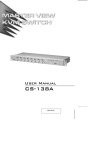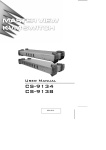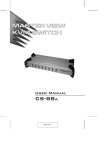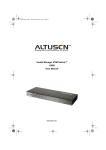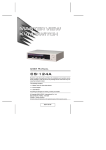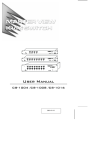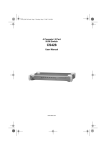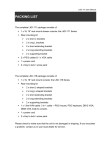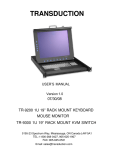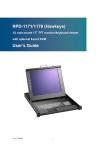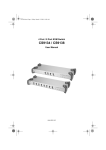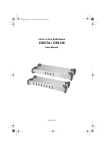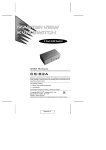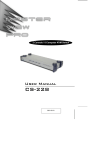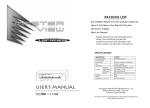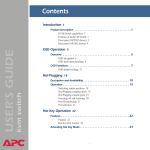Download CS-9134 CS-9138 - Pdfstream.manualsonline.com
Transcript
User Manual CS-9134 CS-9138 2005-12-21 This equipment has been tested and found to comply with the limits for a Class A digital device, pursuant to Part 15 of the FCC Rules. These limits are designed to provide reasonable protection against harmful interference when the equipment is operated in a commercial environment. This equipment generates, uses and can radiate radio frequency energy and, if not installed and used in accordance with the instruction manual, may cause harmful interference to radio communications. Operation of this equipment in a residential area is likely to cause harmful interference in which case the user will be required to correct the interference at his own expense. 2005-12-21 Packing List The complete Master View CS-9134 / CS-9138 package consists of: w 1 CS-9134 or CS-9138 KVM Switch w 1 Power Adapter w 1 Rack Mounting Kit w 1 User Manual w 1 Quick Start Guide Check to make sure that the unit was not damaged in shipping. If you encounter a problem, contact your dealer. Read this manual thoroughly and follow the installation and operation procedures carefully to prevent any damage to the unit, and/or any of the devices connected to it. ® © Copyright 2001-2006 ATEN International Co., Ltd. Manual Part No. PAPE-0116-501G Printed in China 01/2006 All brand names and trademarks are the registered property of their respective owners. CS-9134 / CS-9138 User Manual 2005-12-21 iii. Contents Packing List . . . . . . . . . . . . . . . . . . . . . . . . . . . . . . . . . iii Contents . . . . . . . . . . . . . . . . . . . . . . . . . . . . . . . . . . . iv Overview . . . . . . . . . . . . . . . . . . . . . . . . . . . . . . . . . . . 1 Features . . . . . . . . . . . . . . . . . . . . . . . . . . . . . . . . . . . 2 Hardware Requirements. . . . . . . . . . . . . . . . . . . . . . . . . . . 3 Console . . . . . . . . . . . . . . . . . . . . . . . . . . . . . . . . . . 3 Computers. . . . . . . . . . . . . . . . . . . . . . . . . . . . . . . . . 3 Cables . . . . . . . . . . . . . . . . . . . . . . . . . . . . . . . . . . . 3 Introduction . . . . . . . . . . . . . . . . . . . . . . . . . . . . . . . . . 4 CS-9134 Front View . . . . . . . . . . . . . . . . . . . . . . . . . . . . 4 CS-9138 Front View . . . . . . . . . . . . . . . . . . . . . . . . . . . . 5 Rear View . . . . . . . . . . . . . . . . . . . . . . . . . . . . . . . . . 6 Installation . . . . . . . . . . . . . . . . . . . . . . . . . . . . . . . . . . 7 Before you Begin . . . . . . . . . . . . . . . . . . . . . . . . . . . . . 7 Single Station Installation . . . . . . . . . . . . . . . . . . . . . . . . . 7 Two Stage Installation . . . . . . . . . . . . . . . . . . . . . . . . . . . 8 Three Stage Installation . . . . . . . . . . . . . . . . . . . . . . . . . . 9 Operation . . . . . . . . . . . . . . . . . . . . . . . . . . . . . . . . . . 11 Hot Plugging . . . . . . . . . . . . . . . . . . . . . . . . . . . . . . . 11 Powering Off and Restarting . . . . . . . . . . . . . . . . . . . . . . . 12 Port Selection . . . . . . . . . . . . . . . . . . . . . . . . . . . . . . 13 Port ID Numbering . . . . . . . . . . . . . . . . . . . . . . . . . . . . 14 Port Key In Examples . . . . . . . . . . . . . . . . . . . . . . . . . . 15 OSD . . . . . . . . . . . . . . . . . . . . . . . . . . . . . . . . . . . . . 16 OSD Overview . . . . . . . . . . . . . . . . . . . . . . . . . . . . . . 16 OSD Navigation . . . . . . . . . . . . . . . . . . . . . . . . . . . . . 17 OSD Hotkey Navigation . . . . . . . . . . . . . . . . . . . . . . . . . 17 OSD Main Screen Headings . . . . . . . . . . . . . . . . . . . . . . . 18 The Function Keys . . . . . . . . . . . . . . . . . . . . . . . . . . . . 18 Factory Default Settings . . . . . . . . . . . . . . . . . . . . . . . . . 24 OSD Security. . . . . . . . . . . . . . . . . . . . . . . . . . . . . . . 24 Appendix . . . . . . . . . . . . . . . . . . . . . . . . . . . . . . . . . . 25 Computer Connection Tables . . . . . . . . . . . . . . . . . . . . . . 25 Troubleshooting . . . . . . . . . . . . . . . . . . . . . . . . . . . . . 26 Stacking and Rack Mounting. . . . . . . . . . . . . . . . . . . . . . . 27 Specifications . . . . . . . . . . . . . . . . . . . . . . . . . . . . . . 29 iv. CS-9134 / CS-9138 User Manual 2005-12-21 Overview The Master View CS-9134 and CS-9138 KVM switches are control units that allow access to multiple computers from a single console (keyboard, monitor, and mouse). Before the development of the Master View, the only way to control multiple computer configurations from a single console was through a complex and costly network system. Now, with the Master View CS-9134 / CS-9138, you can easily access multiple computers in a cost effective manner. A single Master View CS-9134 or CS-9138 can control up to 4 or 8 computers, respectively. Since the switches can be cascaded to three levels, in a full three stage installation up to 21 CS-9134 Master Views can control up to 64 computers and 73 CS-9138 Master Views can control up to 512 computers - all from a single console. Setup is fast and easy; plugging cables into their appropriate ports is all that is entailed. There is no software to configure, so there is no need to get involved in complex installation routines or be concerned with incompatibility problems. Because the CS-9134 / CS-9138 intercepts keyboard input directly, it works on any hardware platform and with all operating systems. There are three convenient methods to access any computer connected to the system: (1) using the push button port selection switches located on each unit’s front panel; (2) entering Hotkey combinations from the keyboard; and (3) selecting from menus provided by the OSD (On Screen Display) feature. A powerful Quick View Scan feature also permits auto scanning and monitoring the activities of all operating computers on the installation one by one. There is no better way to save time and money than with a Master View CS-9134 / CS-9138 installation. By allowing a single console to manage all the attached computers, a Master View CS-9134 / CS-9138 installation: (1) eliminates the expense of having to purchase a separate keyboard, monitor, and mouse for each computer; (2) saves all the space those extra components would take up; (3) saves on energy costs; and (4) eliminates the inconvenience and wasted effort involved in constantly moving around from one computer to another. CS-9134 / CS-9138 User Manual 2005-12-21 1 Features w Cascadable To Three Levels - Control Up to 64 (CS-9134) or 512 (CS-9138) Computers From a Single Console w No Software Required - Computer Selection via Front Panel Switches, Hot Keys, or OSD (On Screen Display) w Quick View Scan Feature for Monitoring Selected Computers w PS/2 and Serial Mouse Emulation For System Bootup w Console’s PS/2 Mouse Controls All Connected Computers - Even Those With Serial Mice w PS/2 Compatible Mouse Support - Microsoft Intellimouse Explorer and Logitech FirstMouse+ Support* w SVGA, VGA, and Multisync Monitor Support w Superior Video Quality; 1920 x 1440; DDC; DDC2; DDC2B w LED Display For Easy Status Monitoring w Supports High Quality CS Series Custom Connector Cables w Hot Pluggable - Add or Remove Computers for Maintenance Without Powering Down the Switch w Rack Mountable in 19" System Rack * 2 1. PS/2 compatible mouse support is for three button (wheel) mice. 2. The Logitech Mouse Ware program’s Change Device procedure does not work on Microsoft NT systems. CS-9134 / CS-9138 User Manual 2005-12-21 Hardware Requirements Console w A VGA, SVGA, or Multisync monitor capable of the highest resolution that you will be using on any computer in the installation. w A PS/2 style mouse w A PS/2 style keyboard Computers The following equipment must be installed on each computer: w A VGA, SVGA or Multisync card. w Either a 6-pin mini-DIN (PS/2 style), or DB-9 (standard serial), mouse port. w Either a 6-pin mini-DIN (PS/2 style) keyboard port with +5V DC on pin 4 and Ground on pin 3, or a 5-pin DIN (AT style) keyboard port with +5V DC on pin 5 and ground on pin 4.* * See the note under Cables in the next section. Cables Use of substandard cables may damage the connected devices or degrade overall performance. For optimum signal integrity and to simplify the layout, we strongly recommend that you use the following high quality CS Custom Cable sets: Connector Purpose AT (5 pin DIN) Keyboard and Serial Mouse CS Cable Part Number 2L-1001P/C (1.8m) or 2L-1003P/C (3m) PS/2 (6 pin mini-DIN) Keyboard and Mouse Cascading Master Views Note: 1. If your computer uses a standard AT style keyboard socket you will need to purchase a PS/2-to-AT keyboard adapter (Part No. 2A-106, or any standard keyboard adapter). 2. If your computer uses a standard 9 pin serial port for the mouse, you will need to purchase a special PS/2-to-Serial mouse adapter (Part No. 2A-105); a standard mouse adapter will probably not work). 3. Because of the wiring and pin assignments, you cannot use a Serial-to-PS/2 adapter at the end that plugs into the switch. Attempting to use a standard serial extender cable with adapters at both ends will fail. CS-9134 / CS-9138 User Manual 2005-12-21 3 Introduction CS-9134 Front View 1 K/M RESET AUTO SCAN 2 3 4 5 1. Port Selection Switches Press a switch to access the computer attached to the corresponding port. w Pressing Buttons 1 and 2 simultaneously for 3 seconds performs a Keyboard and Mouse Reset. w Pressing Buttons 3 and 4 simultaneously starts Auto Scan Mode. 2. Port LEDs The Port LEDs are built into the Port Selection Switches. The upper ones are the On Line LEDs; the lower ones are the Selected Port LEDs: w An On Line LED lights GREEN to indicate that the computer attached to its corresponding port is up and running. If the LED is flashing, it indicates that the Port is being used for cascading to another Master View switch. w A Selected LED lights ORANGE to indicate that the computer attached to its corresponding port is the one that has the KVM focus. The LED is steady under normal conditions, but flashes when its port is accessed under Auto Scan Mode. 3. Sound opening System sounds (beeps, etc.) are emitted from this opening. 4. Reset Use a thin object (such as the end of a paper clip, or a ballpoint pen), to press this recessed switch in to initiate a warm reset. If the switch is kept in for longer than three seconds, a cold reset takes place. 5. Power LED Lights to indicate that the unit is receiving power. 4 CS-9134 / CS-9138 User Manual 2005-12-21 CS-9138 Front View 1 K/M RESET AUTO SCAN 2 3 4 5 1. Port Selection Switches Press a switch to access the computer attached to the corresponding port. w Pressing Buttons 1 and 2 simultaneously for 3 seconds performs a Keyboard and Mouse Reset. w Pressing 7 and 8 simultaneously starts Auto Scan Mode. 2. Port LEDs The Port LEDs are built into the Port Selection Switches. The upper ones are the On Line LEDs; the lower ones are the Selected Port LEDs: w An On Line LED lights GREEN to indicate that the computer attached to its corresponding port is up and running. If the LED is flashing, it indicates that the Port is being used for cascading to another Master View switch. w A Selected LED lights ORANGE to indicate that the computer attached to its corresponding port is the one that has the KVM focus. The LED is steady under normal conditions, but flashes when its port is accessed under Auto Scan Mode. 3. Sound opening System sounds (beeps, etc.) are emitted from this opening. 4. Reset Use a thin object (such as the end of a paper clip, or a ballpoint pen), to press this recessed switch in to initiate a warm reset. If the switch is kept in for longer than three seconds, a cold reset takes place. 5. Power LED Lights to indicate that the unit is receiving power. CS-9134 / CS-9138 User Manual 2005-12-21 5 Rear View 1 2 1 2 3 3 1. Power Jack The unit is designed to be non-powered (external power is not required - its operating power comes from the computers). In general, the only time that external power is necessary is when you cascade it, or if operation becomes erratic because the unit isn’t obtaining enough power from the computer connections. If you choose to use external power, the power adapter cable plugs in here. 2. Console Port Section w If this is a first station unit, your monitor, keyboard and mouse plug in here. w If this is a daisy chained unit, the cables that link back to a port on a higher Master View unit plug in here. 3. CPU Port Section The cables that link to the computers plug in here. 6 CS-9134 / CS-9138 User Manual 2005-12-21 Installation Before you Begin 1. Make sure that the power to each of the devices you will be connecting up has been turned off. You must unplug the power cords of any computers that have the Keyboard Power On function. 2. Make sure that all devices on the installation are properly grounded. Single Station Installation In a Single Stage installation, there are no additional Master View’s cascaded down from the first unit. To set up a single stage installation do the following: 1. Plug your keyboard, mouse, and monitor into the unit’s Console Ports. 2. Use KVM cable sets (as described in the Cables section on p. 3), to connect any available CS-88A CPU Port to the Keyboard, Video and Mouse ports of the computer you are installing. 3. If you choose to use external power, plug the power adapter cable into the Master View’s Power Jack, then plug the adapter into an AC power source. Note: The switch is designed for non-powered operation in a single stage installation by taking its power from the computers via the KVM cables. If a computer, only supplies 3.3V of power for the keyboard and mouse instead of 5V (as in the case of Notebooks, for example), the unit will not receive enough power, and you will need to use the external power adapter. 4. Turn on the power to the computers. Note: If you choose to use external power, the Master View unit must be plugged in and receiving power prior to turning on the power to the computers. CS-9134 / CS-9138 User Manual 2005-12-21 7 Two Stage Installation To control even more computers, up to four (CS-9134) or eight (CS-9138) additional Master View units can be cascaded from the CPU ports of the First Stage unit. The cascaded Master Views that connect back to the First Stage unit are considered Second Stage units. As many as 16 (CS-9134) or 64 (CS-9138) computers can be controlled in a complete two stage installation. Tables showing the relation between the number of computers and the number of Master View units needed to control them are provided in the Appendix. Note: Mixing different Master View models on the same installation can cause problems with OSD port switching. We strongly recommend that all cascaded units be the same model as the First Stage unit. To set up a two stage installation, do the following: 1. Make sure that power to all the devices you will be connecting up, including all preexisting devices on the installation, have been turned off. 2. Use a KVM cable set (described in the Cables section, p. 3), to connect any available CPU Port on the First Stage unit to the Console Port connectors of the Second Stage unit. 3. Use KVM cable sets (described in the Cables section, p. 3), to connect any available CPU port on the Second Stage unit to the Keyboard, Video, and Mouse ports of the computers you are installing. 4. Plug the power adapter cable into the Master View’s Power Jack, then plug the adapter into an AC power source. 5. Repeat these steps for any other Second Stage units you wish to connect. 6. Plug in the power adapter for the First Stage Master View unit. 7. Turn on the power to all the computers. Note: The Power On sequence requires that all Second Stage units be powered on first. After all the Second Stage units have been powered on, the First Stage unit must be powered on next. After the Second and First stage units have been powered on, the computers can be powered on. 8 CS-9134 / CS-9138 User Manual 2005-12-21 Three Stage Installation The procedures for setting up a three stage installation are essentially the same as for a two stage installation. With a three stage setup, as many as 64 (CS-9134) or 512 (CS-9138) computers can be controlled in a complete installation. A table showing the relation between the number of computers and the number of Master View units needed to control them is provided in the Appendix. Note: Master View units cannot be cascaded beyond the third level. To set up a three stage installation, do the following: 1. Make sure that power to all the devices you will be connecting up, including all preexisting devices on the installation, have been turned off. 2. Use a KVM cable set (described in the Cables section, p. 3), to connect any available CPU Port on the Second Stage unit to the Console Port connectors of the Third Stage unit. 3. Use KVM cable sets (described in the Cables section, p. 3), to connect any available CPU port on the Third Stage unit to the Keyboard, Video, and Mouse ports of the computers you are installing, as shown in the diagram on page 10. CS-9134 / CS-9138 User Manual 2005-12-21 9 4. Plug the power adapter cable into the Master View’s Power Jack, then plug the adapter into an AC power source. 5. Repeat these steps for any other Third Stage units you wish to connect. 6. Plug in the power adapters for all the Second Stage Master View units. 7. Plug in the power adapter for the First Stage Master View unit. 8. Turn on the power to all the computers. Note: The Power On sequence requires that all Third Stage units be powered on first. After they are all on, the Second Stage units must be powered on next. After all the Second Stage units are on, the First Stage unit must be powered on. Only after all the Master Views have been powered on in this sequence, can the computers be powered on. 10 CS-9134 / CS-9138 User Manual 2005-12-21 Operation Hot Plugging The Master View CS-9134 / CS-9138 supports hot plugging. Components can be removed and added back into the installation by unplugging and replugging their cables from their respective ports without the need to shut the switch down. For hot plugging to work properly, the following procedures must be observed: u Hot Plugging CPU Ports: When hot plugging cables from the CPU ports: 1. The cable must be plugged back into the same port it was removed from. 2. The mouse cable must be plugged in before the keyboard cable. 3. After plugging the cable back in, you must perform a KVM Reset on the First Stage unit (by pressing the Reset switch In). u Hot Plugging Console Ports: The unit supports hot plugging of the keyboard, monitor, and mouse. When hot plugging the mouse from the console mouse port: 1. You may unplug the mouse and plug it back in again (to reset the mouse, for example), as long as you use the same mouse. 2. If you plug in a different mouse, all the stations and all the computers on the installation must be shut down for 10 seconds, then restarted. (Refer back to the note describing the Power On sequence on p. 10, if necessary.) Note: If, after hot plugging (or at any other time), there is no response to mouse and/or PS/2 keyboard input, simultaneously press and hold Port Select buttons 1 and 2 on the First Stage unit for 3 seconds to perform a PS/2 Keyboard and PS/2 Mouse reset. CS-9134 / CS-9138 User Manual 2005-12-21 11 Powering Off and Restarting If it becomes necessary to Power Off one of the Master View units, before starting it back up you must do the following: 1. Shut down all the computers that are attached to the unit. If there are Master View stations cascaded down from it, all the cascaded stations and the computers attached to them must be shut down, as well. Note: 1. You must unplug the power cords of any computers that have the Keyboard Power On function that are connected to the shut down switches. Otherwise, the switches will still receive power from the computers. 2. If the unit is operating under external power, unplug the power adapter cable. 2. Wait 10 seconds, then plug the stations back in, starting with the lowest stations in the chain and working back to the station you originally shut down. 3. After all the Master View’s are up, power On the computers, starting with the ones attached to the lowest stations in the chain and working back to the station you originally shut down. Toggling the buzzer The buzzer can be toggled on and off with a hotkey combination as follows: 1. Press [Ctrl]+[Shift]+[Alt] to invoke the hotkey function. 2. Press [B], then press [Enter]. Note: You must press [B] and [Enter] withing 1 second. The default is for the buzzer to be On. 12 CS-9134 / CS-9138 User Manual 2005-12-21 Port Selection The Master View CS-9134 / CS-9138 provides three methods to obtain instant access to any computer in your installation: Manual, Hotkey, and OSD. u Manual Simply press the appropriate Port Selection Switch on the Master View’s front panel. After you press the switch, the Selected LED lights to indicate that the port has the KVM focus. The OSD (see p. 16) automatically switches to highlight the computer that you have selected. Note: 1. On a cascaded installation, you must press the Port Selection switch on the Master View Station that connects directly to the computer you want to access. 2. Simultaneously pressing Port Selection buttons 3 and 4 (CS-9134) or 7 and 8 (CS-9138) on the First Stage unit initiates the Auto Scan feature, in which all the ports currently selected for Quick View scanning with the OSD’s F4 QV function (see p. 21), are cycled through. The length of time spent on each port is determined OSD’s F6 SET function (see p. 22). u Hotkey Hotkeys allow you to conveniently provide KVM focus to a particular computer from the keyboard, instead of having to manually select it by pressing a Port Selection switch. To select a port with the Hotkey method, do the following: 1. Press [Ctrl]+[Shift]+[Alt] to invoke the hotkey function. 2. Key in the Port ID number (see Port ID Numbering on p. 14), then press [Enter]. Note: 1. Press the keys in sequence - one key at a time. First [Ctrl], then [Shift], then [Alt]. 2. After invoking the hotkey function with the [Ctrl]+[Shift]+[Alt] combination, you must key in the Port ID and press [Enter] within 1 second for each keypress. u OSD OSD (On Screen Display), provides a menu driven interface to handle the computer switching procedure to provide instant access to any computer on the installation. OSD operation is discussed in detail beginning on p. 16. CS-9134 / CS-9138 User Manual 2005-12-21 13 Port ID Numbering Each CPU Port on a Master View installation is assigned a unique Port ID. You can directly access any computer on any level of the installation by specifying the Port ID of the CPU port that the computer is connected to either with the Hotkey port selection method, or with the OSD. The Port ID is a one, two, or three digit number. It is determined by the Stage Level and CPU Port number of the Master View unit that a computer is connected to. The first digit represents the CPU Port number of the First Stage unit; the second digit represents the CPU Port number of the Second Stage unit; the third digit represents the CPU Port number of the Third Stage unit. w A computer attached to a First Stage unit has a one digit Port ID (from 1 to 4 for the CS-9134; from 1 to 8 for the CS-9138), that corresponds to the CPU Port number that the computer is connected to. w A computer attached to a Second Stage unit has a two digit Port ID: w The first digit represents the CPU Port number on the First Stage unit that the Second Stage unit links back to. w The second digit represents the CPU Port number on the Second Stage unit that the computer is connected to. For example, a Port ID of 2 3 refers to a computer that is connected to CPU Port 3 of a Second Stage unit that links back to CPU Port 2 of the First Stage unit. w Likewise, a computer attached to a Third Stage unit has a three digit Port ID. A Port ID of 2 4 1 refers to a computer that is connected to CPU Port 1 of a Third Stage unit, that links back to CPU Port 4 of a Second Stage unit, which, in turn, links back to CPU Port 2 of the First Stage unit. 14 CS-9134 / CS-9138 User Manual 2005-12-21 Port Key In Examples 1. To access a computer attached to port 3 of a Single Stage installation, key in 3 for the Port ID, as follows: [Ctrl]+[Shift]+[Alt] 3 [Enter] 2. To access a computer attached to port 3 of a Second Stage unit that is cascaded down from port 2 of the First Stage unit, key in 2 3 for the Port ID, as follows: [Ctrl]+[Shift]+[Alt] 2 3 [Enter] Note: You must key in the numbers one at a time. 3. To access a computer attached to port 1 of a Third Stage unit that is cascaded down from port 4 of a Second Stage unit, which, in turn, is cascaded down from port 2 of the First Stage unit, key in 2 4 1 for the Port ID, as follows: [Ctrl]+[Shift]+[Alt] 2 4 1 [Enter] CS-9134 / CS-9138 User Manual 2005-12-21 15 OSD OSD Overview The On Screen Display (OSD) provides a menu driven interface to handle all computer control and switching procedures. Although Hotkey switching still works, using OSD is a great deal more convenient - especially in large, cascaded installations where it is difficult to keep track of which port a particular computer is attached to. All operations start from the OSD Main Menu. To pop up the Main Menu, tap either Ctrl key twice. Note: 1. The keys must be on the same side (both left, or both right). 2. You can optionally change the Hotkey to the Scroll Lock key (see OSD Activating Hotkey, p. 22), in which case you would tap [Scroll Lock] twice. When you invoke the OSD, a screen similar to the one below appears: OSD always starts in List view, with the highlight bar at the same position it was in the last time it was closed. The next two sections explain how to navigate using the OSD and OSD Hotkey methods. 16 CS-9134 / CS-9138 User Manual 2005-12-21 OSD Navigation w [Esc] cancels the current selection, or dismisses the current menu and moves back to the menu one level above. If you are at the highest menu level, it deactivates OSD. w To move up or down through the list one line at a time, Click the Up and Down Triangle symbols (st), or use the Up and Down Arrow Keys. If there are more items than appear on the screen, the screen will scroll. w To move up or down through the list one screen at a time, Click the Up and Down Arrow symbols (ÈÊ), or use the [Pg Up] and [Pg Dn] keys. If there are more items than appear on the screen, the screen will scroll. w To activate a port, move the Highlight Bar to it then press [Enter]. w After executing any action, you automatically go back to the menu one level above. OSD Hotkey Navigation Hotkey navigation can also be used under OSD as follows: 1. From the OSD Main Menu, press [Ctrl]+[Shift]+[Alt]. 2. Key in the Port ID for the computer you wish to access (see Port ID Numbering, p. 14), then press [Enter]. The console now controls the computer that you have selected, and the OSD automatically closes. When you use this method, note the following: w Although access switches to the port you just specified, the highlight bar on the OSD screen doesn’t move. w You must press [Ctrl], [Shift], [Alt] one after the other - not all at the same time. w After pressing the [Ctrl]+[Shift]+[Alt] combination, you must key in the Port ID and press [Enter] within 1 second for each keypress. w The keys must be pressed and released one key at a time. w Number keys must be pressed from the regular keyboard; not from the numeric keypad. w If you submit an incorrect Port ID, an error message displays, and you are returned to the OSD Main Menu. CS-9134 / CS-9138 User Manual 2005-12-21 17 OSD Main Screen Headings Heading Explanation PN This column lists the Port ID numbers (Station Number - Port Number), for all the CPU ports on the installation. The simplest method to access a particular computer is move the Highlight Bar to it, then press [Enter]. QV If a port has selected for Quick View scanning (see F2 and F4, below), an arrowhead symbol displays in this column to indicate so. PC The computers that are powered on and are On Line have a Plus sign ( + ) in this column to indicate so. NAME If a port has been given a name (see F5, below), its name appears in this column. The Function Keys Pressing a Function Key brings up a submenu that is used to configure and control the OSD. For example, you can: rapidly switch to any port; scan selected ports only; limit the list you wish to view; designate a port for Quick View scanning; create or edit a port name; or make OSD setting adjustments. u F1 GOTO: GOTO allows you to switch directly to a port by either of the following two methods: 1. Move the Highlight Bar to the port you want, then press [Enter]. 2. Key in the Port ID or Name, then press [Enter]. Note: GOTO has a special feature that narrows the list of available choices as you type the name. For example, if the first letter you type is a, the list only displays those ports whose names begin with a. If the next letter you type is b, the list is narrows down even further to only those ports whose names begin with ab, etc. To return to the OSD Main Menu without making a choice, press [Esc]. 18 CS-9134 / CS-9138 User Manual 2005-12-21 u F2 SCAN: Pressing [F2] initiates Quick View Scanning, in which the OSD cycles through all the ports that are currently selected for this with the QV feature (see F4 QV, below). It stays on each port for the amount of time set with the Scan Duration setting under the F6 SET function (see p. 22). When you want to stop at a particular location, press the [Spacebar] to stop scanning. When you want to stop at a particular location, press the [Spacebar] to stop scanning. Note: 1. If the scanning stops on an empty port, or one where the system is attached but is powered Off, the monitor screen will be blank, and the mouse and keyboard will have no effect. After the Scan Duration time is up, the Scan function will move on to the next port. 2. As each system is accessed, an S appears in front of the Port ID display to indicate that it is being accessed under Quick Scan Mode. CS-9134 / CS-9138 User Manual 2005-12-21 19 u F3 LIST: This function lets you broaden or narrow the scope of which ports the OSD lists. On the submenu that appears, an icon of a pointing finger indicates the currently selected choice. To change a setting, move the highlight bar to the choice you want, then press [Enter]. An explanation of the settings is given in the table below: Choice Meaning ALL Lists the Port ID numbers and Names (if names have been specified see F5, below), of all the ports on the installation. QVIEW Lists only the ports that have been selected for Quick View scanning (see F4, below). POWERED ON + QVIEW Lists only the ports that have been selected for Quick View scanning (see F4, below), and that have their attached computers Powered On. QVIEW + NAME Lists only the ports that have been selected for Quick View scanning (see F4, below), and have been assigned names (see F5, below). NAME Lists only the ports that have been assigned names (see F5, below). POWERED ON Lists only the ports that have their attached systems Powered On. Note: 1. You can access any port on any list by using the Navigation Keys then pressing [Enter]. 2. If you select a port that does not have a computer attached to it, or if the attached system is powered Off, the OSD will still switch to it, and will not show an error. 20 CS-9134 / CS-9138 User Manual 2005-12-21 u F4 QV: QV lets you select which ports you want to include for automatic scanning under the Quick View Scanning function (see F2, above). [F4] is a toggle. To select/deselect a port, move the highlight bar to it, then press [F4]. When a port has been selected, an arrowhead displays in the QV column to indicate so. When a port is deselected, the arrowhead disappears. u F5 EDIT: To help remember which computer is attached to a particular port, every port can be given a name. The EDIT function allows you to create, modify, or delete port names. To edit a port name: 1. Move the highlight bar to the port you want to edit. 2. Press [F5]. 3. Key in the new Port Name, or modify/delete the old one. The maximum number of characters allowed for the Port Name is 15. Legal characters include: w All alpha characters: a - z; A - Z w All numeric characters: 0 - 9 w + - / : . and Space Case does not matter; the OSD displays the Port Name in all capitals no matter how they were keyed in. 4. When you have finished editing, press [Enter] to have the change take effect. To abort the change, press [Esc]. CS-9134 / CS-9138 User Manual 2005-12-21 21 u F6 SET: Pressing [F6] brings up the OSD configuration menu. To change a setting: 1. Move the highlight bar to the choice you want (an icon of a pointing finger indicates which choice is the currently selected one), then press [Enter]. 2. On the submenu that appears, move the highlight bar to the choice you want and press [Enter]. An explanation of the choices is given in the table below: Setting Function CHANNEL DISPLAY MODE Selects how the Port ID is displayed: the Port Number plus the Name (PN + NAME); the Port Number alone (PN); or the Name alone (NAME). CHANNEL DISPLAY DURATION Determines how long a Port ID displays on the monitor after a port change has taken place: 3 Seconds; or Always On. CHANNEL DISPLAY POSITION Allows you to position where the Port ID appears on the screen. Use the Arrow Keys, Pg Up, Pg Dn, Home, End, and 5 (on the numeric keypad with Num Lock off), to position the Port ID display, then press [Enter] to lock the position and return to the SET submenu. SCAN DURATION Determines how long the display dwells on each port as it cycles through the selected ports in Auto Scan Mode. The options are: 3, 5, 10, 15, 20, 30, 40, and 60 seconds. OSD ACTIVATING HOTKEY Selects which Hotkey activates the OSD function: [Ctrl] [Ctrl] or [Scroll Lock] [Scroll Lock]. The default is the Ctrl key combination, but this may conflict with programs running on the systems, in which case, the Scroll Lock option should be used. (Table continues on next page) 22 CS-9134 / CS-9138 User Manual 2005-12-21 Setting Function SET PASSWORD Allows you to set a password in order to control access to: Clearing the Name List; Restoring Default Values; and Locking/Unlocking the Console. See the OSD Security Features section, below, for password setting details. CLEAR THE NAME LIST* Clears all Port Names from the Name List. You are asked to confirm before the procedure goes on. Key in Y, then press [Enter] to confirm. While the names are being cleared, a message appears on the display to indicate so. After the names have been cleared, another message appears to indicate that the procedure completed successfully. RESTORE DEFAULT VALUES* Clears all settings from memory, and returns the unit to the factory default settings (see p. 24). You are asked to confirm before the procedure goes on. Key in Y, then press [Enter] to confirm. While the settings are being cleared, a message appears on the display to indicate so. After the settings have been cleared, another message appears to indicate that the procedure completed successfully. LOCK CONSOLE* Locks / Unlocks the Console. When the Console is locked, only the current monitor screen displays. Attempts to input information from the console have no effect; attempts to switch to a different port, either from the Console or by pressing the manual switches, have no effect either. The only way to regain access to the systems is by Unlocking the Console. If a password has been set, you must provide the password in order to Lock / Unlock the Console. If no password has been set, pressing [Enter] will Lock / Unlock the Console. * If a password has been set, this setting requires you to supply it in order to gain access. See the OSD Security section, below, for details. CS-9134 / CS-9138 User Manual 2005-12-21 23 OSD Factory Default Settings The factory default settings are as follows: Setting Default Display Duration Always On Display Mode The Port Number plus the Port Name Scan Duration 3 Seconds OSD Security In order to prevent unauthorized access to the systems, the OSD provides a password security feature. If a password has been set, the OSD will request that the user specify it before allowing entry. To set a password: 1. Press [F6] to bring up the setup configuration menu. 2. Move the highlight bar to Set Password, then press [Enter]. 3. Key in the new password, then press [Enter]. The password may be up to 8 characters long, and can consist of any combination of letters and numbers (A - Z, 0 - 9). 4. Key in the new password again, in order to confirm that it is correct, then press [Enter]. If the two entries match, the new password is accepted and the screen displays the following message: SET PASSWORD OK If the entries do not match, the screen displays the message: PASSWORD NOT MATCH in which case you must start again from the beginning. Note: To modify or delete a previous password, access the Password function as in Steps 1 and 2, then use the backspace or delete key to erase the individual letters or numbers. 24 CS-9134 / CS-9138 User Manual 2005-12-21 Appendix Computer Connection Tables The following tables indicate the relationship between the number of Master View Units and the number of systems that they control: u CS-9138: MVs Computers MVs Computers MVs Computers MVs Computers 1 8 20 134 - 141 39 267 - 274 58 400 - 407 2 8-15 21 141 - 148 40 274 - 281 59 407 - 414 3 15 - 22 22 148 - 155 41 281 - 288 60 414 - 421 4 22 - 29 23 155 - 162 42 288 - 295 61 421 - 428 5 29 - 36 24 162 - 169 43 295 - 302 62 428 - 435 6 36 - 43 25 169 - 176 44 302 - 309 63 435 - 442 7 43 - 50 26 176 - 183 45 309 - 316 64 442 - 449 8 50 - 57 27 183 - 190 46 316 - 323 65 449 - 456 9 57 - 64 28 190 - 197 47 323 - 330 66 456 - 463 10 64 - 71 29 197 - 204 48 330 - 337 67 463 - 470 11 71 - 78 30 204 - 211 49 337 - 344 68 470 - 477 12 78 - 85 31 211 - 218 50 344 - 351 69 477 - 484 13 85 - 92 32 218 - 225 51 351 - 358 70 484 - 491 14 92 - 99 33 225 - 232 52 358 - 365 71 491 - 498 15 99 - 106 34 232 - 239 53 365 - 372 72 498 - 505 16 106 - 113 35 239 - 246 54 372 - 379 73 505 - 512 17 113 - 120 36 246 - 253 55 379 - 386 18 120 - 127 37 253 - 260 56 386 - 393 19 127 - 134 38 260 - 267 57 393 - 400 CS-9134 / CS-9138 User Manual 2005-12-21 25 u CS-9134: MVs Computers MVs Computers MVs Computers MVs Computers 1 4 7 19 - 22 13 37 - 40 19 55 - 58 2 4-7 8 22 - 25 14 40 - 43 20 58 - 61 3 7 - 10 9 25 - 28 15 43 - 46 21 61 - 64 4 10 - 13 10 28 - 31 16 46 - 49 5 13 - 16 11 31 - 34 17 49 - 52 6 16 - 19 12 34 - 37 18 52 - 55 Troubleshooting Symptom Possible Cause Action Erratic behavior. Unit not receiving enough Use the Power Adapter that was supplied with the power under self-powered unit to provide operation. Pressing the Hotkeys gets no response. Mouse is not responding. 26 The connection from the selected port to the target computer has been broken, or the computer is turned OFF. Check the Online LED for the selected port. If it is not lit: 1. Manually press one of the Select switches to connect to a computer that is powered ON. 2. Check the cables to make sure they are all properly connected. Improper keyboard reset. 1. Reset the keyboard (and mouse) by simultaneously pressing Buttons 1 and 2 on the First Stage unit for 3 seconds. 2. Unplug the keyboard connector from the Console Keyboard Port, then plug it back in. Improper Master View reset. Turn off all Master View units and wait five seconds before turning them back on. See Powering Off and Restarting, p. 12, for details. Incorrectly keying in the Port ID. After invoking the Hotkey function with the [Numlock /] combination, be sure to key in the Port ID and press [Enter] within one second for each key. Improper mouse reset. 1. Reset the mouse (and keyboard) by simultaneously pressing Buttons 1 and 2 on the First Stage unit for 3 seconds. 2. Unplug the mouse connector from the Console Mouse Port, then plug it back in. CS-9134 / CS-9138 User Manual 2005-12-21 Stacking and Rack Mounting u Stacking CS-9134 / CS-9138 switches can be stacked one on top of the other using the stacking brackets that come already attached to the unit. Line up the four bottom brackets of the top unit with the four top brackets of the bottom unit; then fit the top unit down onto the bottom unit. CS-9134 / CS-9138 User Manual 2005-12-21 27 u Rack Mounting To rack mount the unit do the following: 1. First remove the stacking brackets by unscrewing them from the unit, as shown in the diagram below: 2. Next screw the mounting brackets into the sides of the unit, as shown in the diagram below: Phillips hex head M3 x 8 3. Slide the unit into the rack and secure it to the rack. 28 CS-9134 / CS-9138 User Manual 2005-12-21 Specifications Function Computer Connections Console Connectors CPU Connectors CS-9138 Direct 4 8 Max 64 (via Cascade) 512 (via Cascade) Port Selection LEDs CS-9134 Front Panel Switches; Hotkeys; OSD Power 1 (Blue) On Line 4 (Green) 8 (Green) Selected 4 (Orange) 8 (Orange) Keyboard 1 x 6 pin mini DIN female Mouse 1 x 6 pin mini DIN female Video 1 x HDB -15 female Keyboard 4 x 6 pin mini DIN female 8 x 6 pin mini DIN female Mouse 4 x 6 pin mini DIN female 8 x 6 pin mini DIN female Video 4 x HDB -15 male 8 x HDB -15 male Resolution 1920 x 1440; DDC; DDC2; DDC2B Scan Interval 3, 5, 10, 15, 20, 30, 40, 60 secs. Power Consumption DC9V; 1.62W (max.) DC9V; 1.98W (max.) o Operating Temperature 5 - 40 C Storage Temperature -20 - 60o C Humidity 0 - 80% RH Housing Metal Weight 2.5 Kg Dimensions (L x W x H) 48.3 x 15.0 x 4.45cm (19" 1U) CS-9134 / CS-9138 User Manual 2005-12-21 2.85 Kg 29 Limited Warranty IN NO EVENT SHALL THE DIRECT VENDOR’S LIABILITY EXCEED THE PRICE PAID FOR THE PRODUCT FROM THE DIRECT, INDIRECT, SPECIAL, INCIDENTAL OR CONSEQUENTIAL DAMAGES RESULTING FROM THE USE OF THE PRODUCT, DISK OR ITS DOCUMENTATION. The direct vendor makes no warranty or representation, expressed, implied, or statutory with respect to the contents or use of this documentation, and specially disclaims its quality, performance, merchantability, or fitness for any particular purpose. The direct vendor also reserves the right to revise or update the device or documentation without obligation to notify any individual or entity of such revisions, or update. For further inquires please contact your direct vendor. 30 CS-9134 / CS-9138 User Manual 2005-12-21


































